8 Spring Lawn Care Tips for Columbus, OH
BY ANDIE IOO | APRIL 12TH, 2023 | COLUMBUS, LAWN CARE, OHIOColumbus is known for the Ohio Statehouse, a love of football, its arts scene – and unpredictable weather. While it’s hard to compete with Scioto Mile’s perfect green spaces, transforming your Arch City yard into a lush oasis isn’t as hard as it sounds.
We’ve put together eight spring lawn care tips for Columbus to help you understand your lawn’s needs in the spring so it can thrive year-round.
In this article, we’ll cover:
- Why is Lawn Care Important in the Spring?
- 8 Spring Lawn Care Tips for Columbus
- FAQ About Spring Lawn Care in Columbus
Why is Lawn Care Important in the Spring?
To enjoy a fresh, healthy lawn in the summer, you’ll need to hit the ground running in the spring. This is when your lawn responds to nature’s wake-up call after a long, cold Columbus winter.
From mowing, watering, and fertilizing to treating lawn diseases, springtime lawn care is important if you want to enjoy a thick carpet of green come summer.
By tackling a few tasks early, you’ll help your lawn defend itself against potential diseases, drought, and pests. With the proper maintenance, not only will your lawn burst with health, but it will seriously boost your curb appeal and make you the envy of your neighborhood.
8 Spring Lawn Care Tips for Columbus
1. Get Your Lawn Care Equipment Ready
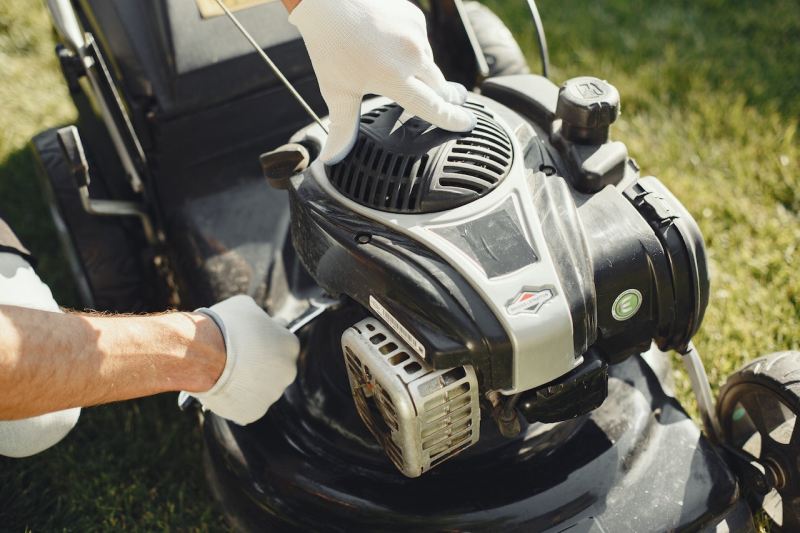
Photo Credit: Pexels
If it’s springtime, it’s preparation time. Before the grass begins to grow, you’ll want to make sure your lawn equipment is in perfect working condition.
Here are some key maintenance checks you should perform sooner rather than later:
- If your lawn mower is gas-powered, make sure you have enough gas.
- If your lawn mower is battery-powered, check and charge it if necessary.
- Sharpen or replace your lawn mower’s blades.
- Check your lawn mower’s spark plugs and air, oil, and fuel filters.
Maintenance makes a big difference, so get your tools ready ahead of time and have a stress-free summer.
2. Test Your Soil
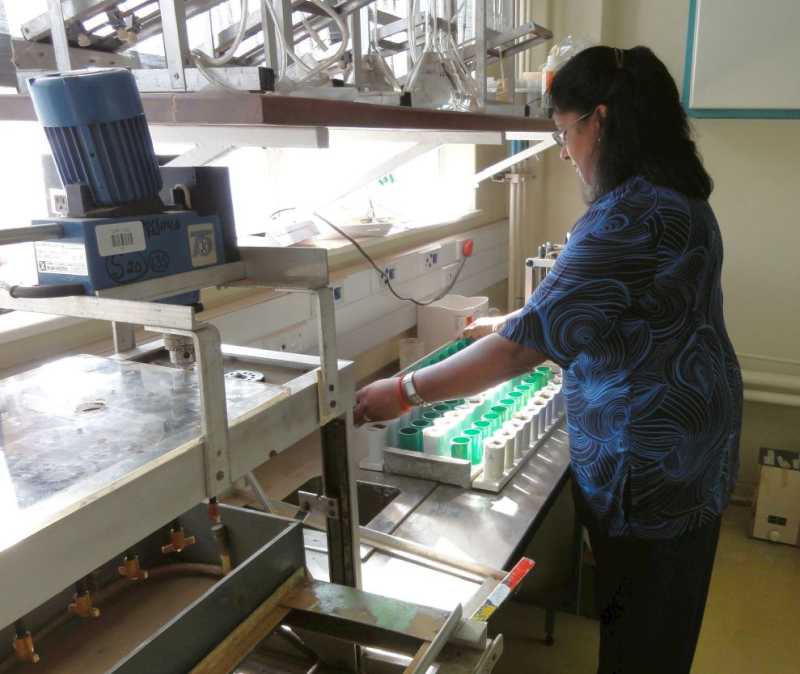
Photo Credit: Alandmanson / Wikimedia Commons / CC BY-SA 4.0
Full, lush lawns can be a beautiful sight, but a lot goes into achieving and maintaining them. If yours isn’t exactly thriving, your soil could be the problem.
Depending on each yard, soil composition and acidity levels can differ. By conducting a soil test, you’ll be able to pinpoint soil nutrient needs. Specifically, you’ll get information on soil pH, cation exchange capacity, lime requirement index, and base saturation.
Plus, you’ll find out how much phosphorus (P), potassium (K), calcium (Ca) and magnesium (Mg) your soil contains and whether you need to add soil amendments.
3. Water Smartly and Efficiently
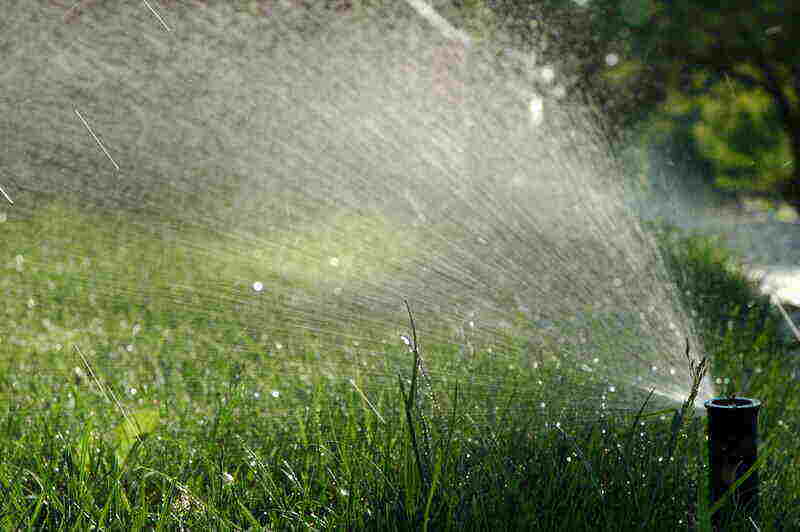
Photo Credit: UBC Micrometeorology / Flickr / CC BY 2.0
In early spring, there is still enough rain to keep your lawn moist and healthy. Consider watering your lawn when you notice the first signs of grass growth. Once you start, make sure your cool-season grass gets around 1 inch of water per week. Balance is essential, and it’s best to let your lawn guide you.
It’s also incredibly important to let your lawn dry between waterings. Too much water can invite fungal disease, weeds, and pests, something neither your lawn nor you will appreciate. While flowers and other landscape plants can handle everyday watering, don’t include your lawn in this schedule.
Watering deeply, but more infrequently, will lead to stronger root development and drought-resistance than doing so briefly every day.
Signs of an overwatered lawn:
- Insect infestation
- Fungus discoloration
- Thatch or weeds sticking out
- A lawn that feels squishy when you step on it
- Streams of water running off your grass
Underwatering won’t do your lawn any favors either. Not keeping up with regular watering will leave your turf looking dry and unhealthy. Your grass will turn gray or tan, and it will have imprints when you walk on it.
The best time to water your lawn is before 10 a.m., preferably around 5 or 6 a.m. Your grass will be able to absorb the moisture before it evaporates. In the afternoon, try to water between 4 and 6 p.m. Watering late at night will make your lawn more susceptible to disease, as the moisture will just sit on your grass overnight.
4. Know When and How Often to Mow
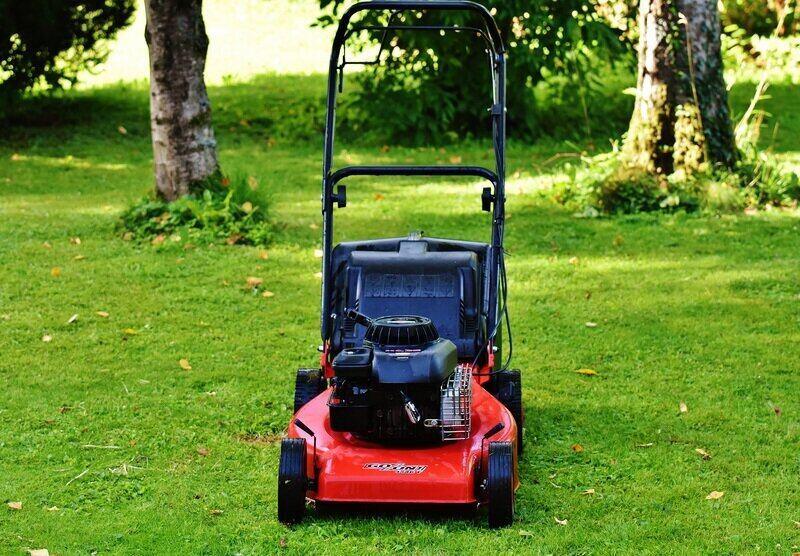
Photo Credit: PxHere
While lawn mowing is an actual ritual for some homeowners, there’s a certain technique involved.
We recommend waiting until your grass is at least 2 inches tall. Our table below shows the recommended cutting heights for Columbus cool-season grasses.
| Grass type | Recommended height |
| Tall fescue | 3 – 3 ½ inches |
| Kentucky bluegrass | 2 ½ inches |
| Perennial ryegrass | 2 ½ inches |
| Fine fescue | 2 ½ – 4 inches |
Once mowing season kicks off, follow these simple rules for a healthy lawn:
- Stick to the one-third rule. Never remove more than one-third of the grass blade length. Routine close mowing will produce a brown lawn, harm the crown, and increase vulnerability to disease and pests.
- Avoid mowing when the grass is wet. Dry grass is less brittle, sticks up straight so it’s easier to cut, and clumps less.
- Don’t leave clippings on the grass. While a small amount is recommended for fertilizing purposes, too much will cut off sunlight.
- Don’t mow in the heat. It will put stress on the grass and yourself.
- Reduce mowing frequency and raise the mowing height for cool-season grasses when it’s hot out and their growth rate slows down.
5. Get Weeds Under Control
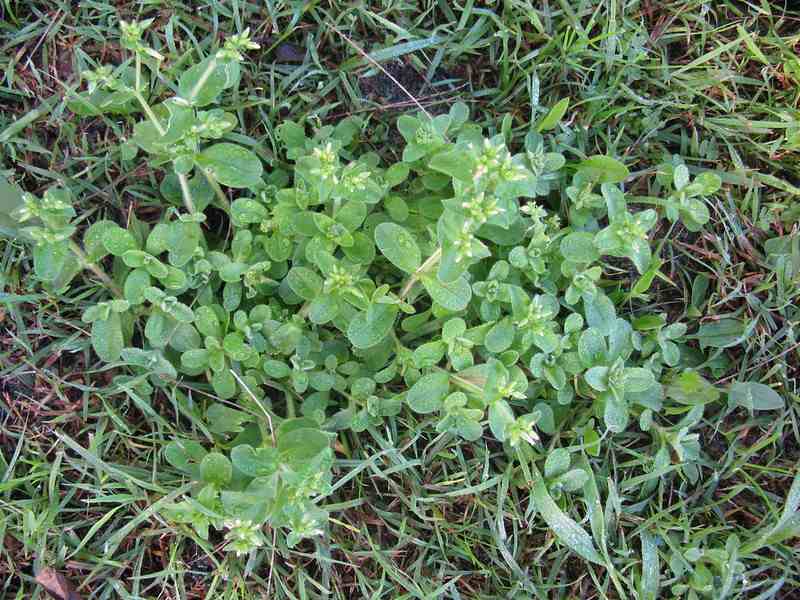
Photo Credit: Harry Rose / Flickr / CC BY 2.0
Chances are you love making good use of your Columbus lawn. What’s not so great? Those annoying weeds that seem to pop up out of nowhere. They’re an eyesore and embarrassment.
You’ll definitely want to get rid of them as soon as they shoot up, but how do you go about it? We provide a couple of ways you can control pesky, deceiving weeds that masquerade as flowers.
If cool-season weeds have taken up residence on your property, you’ll have to invest in post-emergent herbicide. Apply this solution in March or early April and keep in mind that it only targets weeds that have already germinated. It doesn’t work as a preventative measure.
For that, look into a pre-emergent herbicide that targets weed seedlings. Apply it around Mid-March to get ahead of early spring and summer weeds.
Also important to note is the difference between annual and perennial weeds.
Annual cool-season weeds won’t bother you in the warmer months and generally die before you have to take action. On the flip side, perennial weeds are stubborn and stick around for longer, so investing in pre- or post-emergent herbicides will be necessary in this case.
Some of the most common annual and perennial weed types in Columbus include:
- Wild violets
- Thistle
- Dandelions
- Veronica
- White clover
- Chickweed
6. Fertilize to Promote Growth
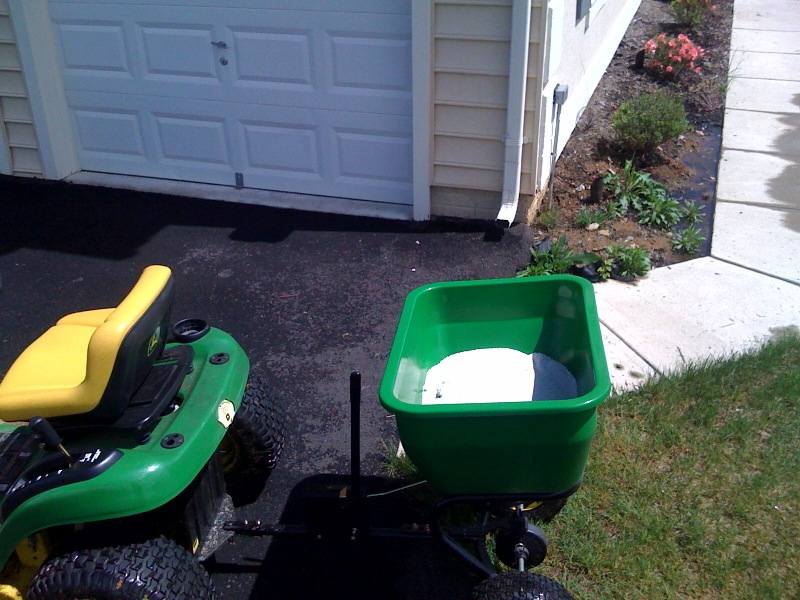
Photo Credit: Dion Hinchcliffe / Flickr / CC BY-SA 2.0
Fertilization helps your grass grow evenly and efficiently and reduces the likelihood of weeds. It supplies your soil with three important nutrients: nitrogen, phosphorus, and potassium. Each nutrient serves a different purpose.
| Nutrient | Key Benefits |
| Nitrogen | • Helps rapid growth and protein synthesis • Increases leaf development for dense lawns |
| Phosphorus | • Helps early root growth • Promotes plant maturity and seed development |
| Potassium | • Increases drought and disease resistance |
Fertilize your Columbus lawn in early to mid spring when your grass begins to grow. This is typically around March or April, when temperatures reach and stay around 50 degrees Fahrenheit. In the early stages of grass growth, when shoots are tender, it’s important to fertilize more lightly. Once grass is actively growing, you can go in with a well-balanced fertilizer.
You also need to think about what kind of fertilizer you want to use for your yard. Controlled-release fertilizers are granular beads that release nutrients over a period of six to eight weeks. Quick-release fertilizers can be a liquid concentrate or water-soluble beads that act as soon as they’re watered.
Take a look at some advantages and disadvantages of both:
| Factors | Controlled-release | Quick-release |
| Advantages | • No toxic buildup on the soil • Helps with water movement and soil structure • Introduces beneficial soil microbes • Safer to use around children and pets | • Lower cost • Highly concentrated • Acts faster • Higher nutrient ratio |
| Disadvantages | • Lower concentrations of nutrients • Takes longer to absorb • Costs more | • Can cause more toxic buildup • Made from synthetic materials • Can pollute groundwater |
Fertilizer can be organic or synthetic and selecting the right one for your lawn is vital. Below, we’ve outlined the pros and cons:
| Factors | Organic fertilizer | Synthetic fertilizer |
| Advantages | • Doesn’t burn lawns • Slow and steady nutrient release • Contains many trace minerals and balanced nutrition for your grass • Improves soil health | • More commonly available • Formulas made for exact lawn needs • Acts quickly • Costs less |
| Disadvantages | • Less nutrient release in cooler temperatures • Costs more • Dependent on microorganisms in the soil • Can cause harmful runoff | • Shorter lifespan • Can deteriorate soil • Can burn lawn • May cause chemical runoff |
How to fertilize your lawn? It’s easier than you think. Run a spreader around the perimeter of your lawn first and then go over the rest of it, slightly overlapping each pass.
The perks? You won’t have to worry about dirty hands and the fertilizer will be spread evenly.
7. Keep Pests at Bay
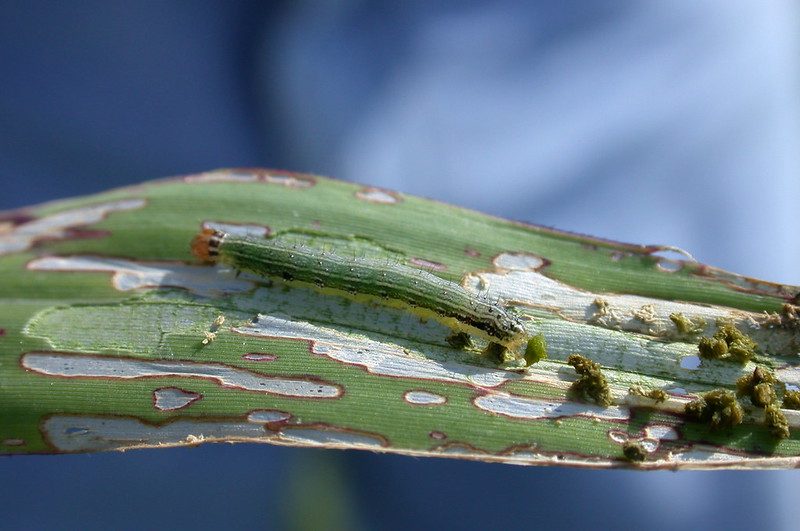
Photo Credit: uacescomm / Flickr / CC0 1.0
Lawn pests. We hate them and want them gone. But they’re stubborn and make it that much harder to achieve the perfect lawn most homeowners dream of.
In Columbus, some of the most common springtime pests include grubs, sod webworms, billbugs, chinch bugs, and cutworms. Read on to find out how to identify them and get rid of them.
Grubs
What are they and how do you identify them? Grubs are the larval stage of different beetle species. As the name implies, they literally grub your grass and attack it at the root level, killing it. When the root system is compromised, grass can’t absorb nutrients and water, leading to severe damage.
Grubs are visible to the eye and have a white or brown body that curls into a C shape if bothered. If you notice beetles flying around, it’s a good sign that you have a grub infestation.
Plus, you’ll likely see irregular dead spots on your lawn and an increase in animal activity on your property. Raccoons, skunks, and birds like to feed on grub worms – which, if you think about it, is a great eradication method.
Ways to get rid of them: In addition to limiting moisture, you can introduce beneficial nematodes to your lawn. It can take a few years to establish a colony large enough to eradicate grubs, but you won’t have to treat your lawn with chemicals.
Another way is to apply milky spore, a bacteria that also takes a while to develop, but which is deadly to grubs. As a last resort, you can turn to pesticides – the lower the toxicity level, the better.
Sod webworms
What are they and how do you identify them? Sod webworms are lawn-damaging caterpillars. They’re the immature larval stage of various moth types. They appear as small, white, or tan in color, with snout-like projections on their heads. They generally cling to grass blades and can be found with their heads pointing down and their wings rolled tight.
You’ll know you have an infestation if you notice moths flying away as you mow. Moreover, your grass will appear brown and short in certain areas.
Ways to get rid of them: Water regularly and keep thatch at an optimal level, to avoid stresses on your lawn. You can also use beneficial nematodes or insecticidal soap to kill this pest. Lastly, you can apply low-toxicity pesticides.
Billbugs
What are they and how do you identify them? Billbugs are particularly troublesome, as both the larvae and adults can damage grass. Adult billbugs chew holes in the grass blades and deposit eggs inside. When they hatch, the larvae start damaging the root system and kill the grass from the inside out.
These insects are a type of weevil and can grow up to ½ inch in length. Their hard shells range in color from brown to near black and have a pitted texture. The larvae are white with reddish-brown heads.
Damage in this case is hard to diagnose. Grass turns brown, but can be mistaken for drought damage, fungal disease, or simply grass dormancy. Test an affected area by pulling out some grass. If billbugs are the culprit, the grass will break off at the soil line and will be accompanied by sawdust-like excrement.
Ways to get rid of them: Billbug treatment calls for multiple approaches. Target adult billbugs in early spring before they lay their eggs and kill off newly-hatched larvae before they have a chance to wreak havoc on your lawn. Also, maintain your lawn height to reduce the ideal habitat for billbugs and treat your lawn with pesticides if needed.
Chinch bugs
What are they and how do you identify them? Chinch bugs are tiny insects that are difficult to spot due to their size. These pests are red in color when they’re young, but turn black as they mature. They also have a white spot on their back in the shape of an ‘X.’ They love St. Augustinegrass and usually live in the thatch layer.
Chinch bug damage can look like lawn disease, with the grass turning brown in patches, but it’s important to never rule out a possible chinch bug infestation.
Ways to get rid of them: If you suspect chinch bugs are damaging your lawn, it’s recommended that you contact a professional. Homeowners can have a difficult time getting rid of them on their own. Worse, these insects are known to develop a resistance to pesticides and overcome resistance in the host plant itself.
Cutworms
What are they and how do you identify them? Cutworms are general feeders that can damage a wide range of plants. They are smooth, with some hairs, and a length of about 2 inches when fully grown. Different species have different colors, from brown or tan to pink, green, gray, or black. Some larvae are shiny, while others are dull.
They curl their bodies around turfgrass blades or plant stems and feed on them. They’re most active in the evening or at night and hide in debris during the day. Adult moths don’t do damage.
Ways to get rid of them: If you discover damage or larvae, you can opt for non-toxic removal methods, such as plucking and crushing the insects or dropping them in soapy water. Furthermore, you can try a wash of bleach-free dish soap or apply organic pesticides.
By keeping up with your lawn care maintenance, you’ll have an easier time squashing any pest problem early. Otherwise, you’ll come up against a damaged lawn and pesky insects that can make spending time outdoors a nightmare.
If you have to use pesticides, stay away from catch-all types that also kill beneficial insects. Instead, go for selective pesticides that act in a targeted way.
8. Treat Lawn Diseases
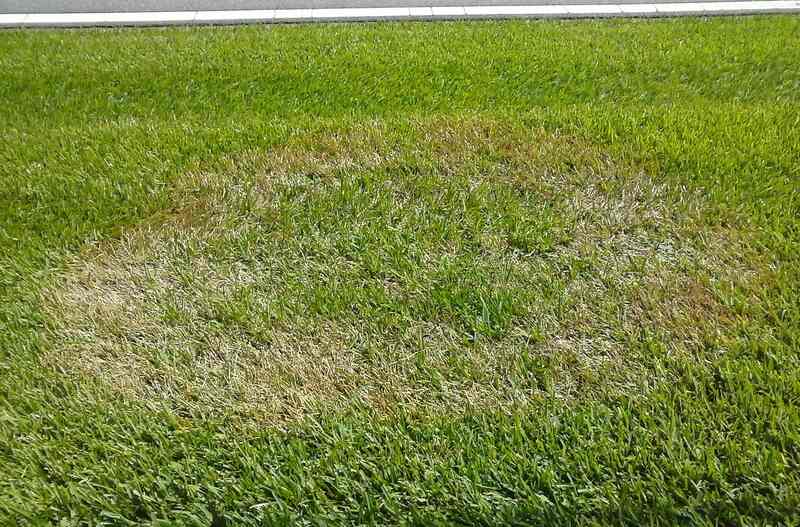
Photo Credit: Scot Nelson / Wikimedia Commons / CC0
Lawn diseases can destroy your yard and cause incredible damage to your grass. If your turf is looking patchy, discolored, or just ‘off,’ lawn disease may be the culprit.
Residents of Columbus regularly deal with abnormally cool periods, intense heat, humidity, overcast skies, and drought, all factors that contribute to fungal growth. A susceptible lawn will easily succumb to disease pathogens, so it’s important to know what you’re dealing with.
Watch out for the following five types affecting Columbus cool-season grasses:
Brown Patch (Rhizoctonia solani)
What to look for:
- Rough, circular patches ranging in size from 1 to 5 feet
- Shades can include anything from tan to brown, with outer edges sometimes appearing darker
- You may also notice white fungal growth
How to treat brown patch:
- Avoid excessive nitrogen fertilization and watering
- Increase air circulation and sunlight and select more resistant cultivars to this disease
- Apply fungicide to strengthen disease control
Dollar Spot (Sclerotinia homoeocarpa)
What to look for:
- Circular, tan spots on grass blades
- Infected blades form rounded, damaged patches the size of a dollar
- Tips generally remain green
- When heavy dew is present, you may notice a white fungal growth, which disappears once the turf dries
How to treat dollar spot:
- Adopt an adequate nitrogen fertilizer program
- Avoid overwatering that keeps turf wet for prolonged periods
- Increase sunlight and air movement
- Provide soil moisture
- Chemical treatments also can be successful if applied early enough
Gray Leaf Spot (Magnaporthe oryzae)
What to look for:
- Symptoms often appear as tiny lesions, which go unnoticed or are mistaken as another disease
- If the turf is susceptible, these spots quickly turn into water soaked lesions that progress to twisted necrotic leaf tips
- If left untreated, the sward will turn gray
How to treat gray leaf spot:
- Certain grasses may benefit from sodding and overseeding
- Your disease control techniques should include adequate nitrogen fertilization, proper watering and irrigation, and fungicide applications
Powdery mildew (Erysiphe graminis)
What to look for:
- The upper surface of the leaf blades may appear covered in a fine, gray-white cobwebby growth
- It can grow to cover the entire blade, as if dusted with talc or flour
- Later stages of the disease will have the turfgrass looking dull white or pale green. It will wither and look thin
How to treat powdery mildew:
- Increase air circulation
- Increase sunlight or use shade-resistant cultivar varieties such as fine fescue or tall fescue
- Apply fungicide in a preventative way
Fairy Ring (Soil borne Basidiomycete fungi)
What to look for:
- Dark green or brown circles
- Mushrooms inside the rings
- Grass that looks taller in the dark green ring
- The thatch area of the rings may smell musty and become covered in a white, fungal mat
How to treat fairy ring:
- Diligently aerate and water
- Apply wetting agents
- Replace infected soil and sod
- Seed if necessary
FAQ About Spring Lawn Care in Columbus
Typically, the fertilizer and soil should be moist, but don’t water so much that puddles begin to form on your grass. About 20 minutes should be enough to avoid washing away the nutrients and carrying away the fertilizer itself. It can contaminate groundwater and nearby streams or ponds.
What are some of the biggest lawn care mistakes to watch out for?
If you’re a homeowner, you’re likely eager to care for your lawn yourself. But there are some things you should know before you start.
• Avoid leaving clippings on your lawn after mowing, as this may kill your grass.
• The best time for aeration and seeding is during the growing season of your particular grass type. Find out when that is and you’ll be good to go.
• Don’t cut your grass with dull lawn mower blades, as they can rip and shred your grass and decrease moisture.
• Don’t over or under water your turf – the former will carry away nutrients and increase the risk of disease, while the latter will dry out your grass.
• Don’t forget to fertilize. Without fertilizer, your grass won’t grow as healthy or green.
If your grass is turning brown and dying despite your best efforts, it may be a result of disease or pests setting up camp. It also may be affected by drought and improper fertilization. Identifying the exact cause will help you find a solution fit for the problem.
Spring lawn care pays off all year long
Columbus cool-season grasses produce beautiful lawns that can survive the region’s fluctuations in temperature. With some targeted springtime lawn care, you’ll be worry-free for the rest of the year and have a lush, healthy carpet of grass at your disposal.
Still, if lawn care is more of a chore than a hobby, hire a Columbus lawn care pro to take your yard to the next level and free up time for other activities.
Main Photo Credit: Topiary Garden / Slowking4 / Wikimedia Commons / CC BY-SA 2.5